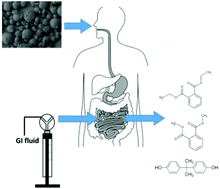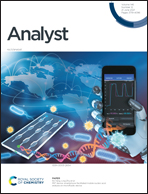An automatic flow-through system for exploration of the human bioaccessibility of endocrine disrupting compounds from microplastics†
Abstract
This article reports on the first attempt towards investigating the leaching rates in the human gastrointestinal (GI) tract of plastic-borne contaminants that can be ingested accidentally using physiologically relevant body fluids. Oral bioaccessibility under fasted and fed states was determined in dynamic mode exploiting an automatic flow setup. The flow system is able to mimic the fast uptake of the released species from the polymeric matrix by absorption in the human digestive system by the in-line removal of the leached species. Complex GI extractants based on the Unified Bioaccessibility Method (UBM, fasted state) and Versantvoort test (fed-state) were brought through a microplastic-loaded metal microcolumn for semi-continuous leaching of plasticizers (phthalic acid ester congeners) and monomer/antioxidant species (bisphenol A, BPA) followed by in-line solid-phase extraction and clean-up of GI extracts prior to liquid chromatography analysis. The temporal extraction profiles were fitted to a first-order kinetic model for the estimation of maximum bioaccessibility pools and apparent leaching rates. Among all studied contaminants, only BPA, dimethylphthalate and diethylphthalate were appreciably released under dynamic GI conditions from high-density polyethylene pellets (average size of 110 μm), with average bioaccessibility values spanning from 51 to 84% and 48 to 87% for UBM and Versantvoort methods, respectively. No statistically significant differences in oral bioaccessibility pools were found under fed- and fasted-state dynamic extractions. The apparent kinetic constants under the fed state were greater by ≥30% as a consequence of the effect of the larger amounts of bile salts and digestive enzymes in the Versantvoort test on the leaching rates. The estimated average daily intake, in which bioaccessibility data are contemplated, indicated that plastic materials exceeding 0.3% (w/w) BPA might pose real risks to human health.

- This article is part of the themed collection: Analyst Recent HOT articles


 Please wait while we load your content...
Please wait while we load your content...